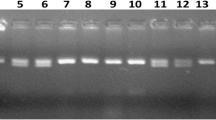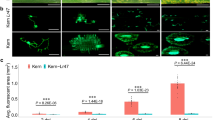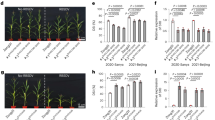Abstract
The disease caused by rice yellow mottle virus (RYMV) is a serious problem for African rice growers in large-scale irrigated programs. As there are very few suitable natural sources of RYMV resistance, we have investigated a transgenic approach using widely grown, RYMV-susceptible cultivars of rice and a transgene encoding the RNA-dependent RNA polymerase of RYMV. Transformed lines were resistant to RYMV strains from different African locations. In the most extreme examples there was complete suppression of virus multiplication. Resistance was stable over at least three generations. Subject to satisfactory field testing, these transgenic lines may be suitable for introduction into RYMV-affected rice-growing areas. In the most resistant line, transcription analysis indicated that the resistance derives from an RNA-based mechanism associated with posttranscriptional gene silencing.
This is a preview of subscription content, access via your institution
Access options
Subscribe to this journal
Receive 12 print issues and online access
$209.00 per year
only $17.42 per issue
Buy this article
- Purchase on Springer Link
- Instant access to full article PDF
Prices may be subject to local taxes which are calculated during checkout





Similar content being viewed by others
References
Fomba, S.N. Screening for seedling resistance to rice yellow mottle virus in some rice cultivars in Sierra Leone. Plant Dis. 72, 641–642 (1988).
Awoderu, V.A. Rice yellow mottle virus in West Africa. Trop. Pest Management 37, 356–362. ( 1991).
WARDA Annual Report of the West African Rice Development Association, Mbé, Côte d'Ivoire (1994).
Bakker, W. in Agricultural research report, No. 829, p. 152 (Centre for Agricultural Publishing and Documentation, Wageningen, The Netherlands; 1974).
IITA annual report of the International Institute of Tropical Agriculture (Ibadan, Nigeria; 1985).
Sanford, J.C. & Johnston, S.A. The concept of parasite-derived resistance-deriving resistance genes from the parasite's own genome. J. Theor. Biol. 113, 395–405 (1985).
Mueller, E., Gilbert, J.E., Davenport, G., Brigneti, G. & Baulcombe, D.C. Homology-dependent resistance: transgenic virus resistance in plants related to homology-dependent gene silencing. Plant J. 7, 1001–1013 (1995).
Lindbo, J.A. & Dougherty, W.G. Pathogen-derived resistance to a potyvirus: immune and resistant phenotypes in transgenic tobacco expressing altered forms of a potyvirus coat protein nucleotide sequence. Mol. Plant-Microbe Interact. 5, 144– 153 (1992).
Lindbo, J.A., Silva-Rosales, L., Proebsting, W.M. & Dougherty, W.G. Induction of a highly specific antiviral state in transgenic plants: implications for regulation of gene expression and virus resistance. Plant Cell 5, 1749–1759 ( 1993).
Smith, H.A., Swaney, S.L., Parks, T.D., Wernsman, E.A. & Dougherty, W.G. Transgenic plant virus resistance mediated by untranslatable sense RNAs: expression, regulation, and fate of nonessential RNAs. Plant Cell 6, 1441– 1453 (1994).
Itoh, K., Nakajima, M. & Shimamoto, K. Silencing of waxy genes in rice containing Wx transgenes . Mol. Gen. Genet. 255, 351– 358 (1997).
Albar, A. et al. Etude du rice yellow mottle virus. Rapport d' Activities 1994-1995. pp 10–14 (Laboratorie de Phytovirologie des Regions Chaudes, BP5035, 34032 Montpellier Cedex 1, France, 1995).
Kumpatla, S.P., Teng, W., Buchholz, W.G. & Hall, T. Epigenetic transcriptional silencing and 5-azacytidine mediated reactivation of a complex transgene in rice. Plant. Physiol. 115, 361– 373 (1997).
Oard, J.H. et al. Development, field evaluation, and agronomic performance of transgenic herbicide resistant rice. Molecular Breeding 2, 359–368 (1996).
Morino, K., Olsen, O-A. & Shimamoto, K. Silencing of an aleurone specific gene in transgenic rice is caused by a rearranged transgene. Plant J. 17, 275–285 (1999).
Hayakawa, T. et al. Genetically engineered rice resistant to rice stripe virus, an insect-transmitted virus. Proc. Natl. Acad. Sci. USA 89, 9865–9869 (1992).
Zheng, H.H. et al. Recovery of transgenic rice plants expressing the rice dwarf virus outer coat protein gene (S8). Theor. Appl. Genet. 94, 522–527 (1997).
Kohli, A., Leech, M., Vain, P., Laurie, D.A. & Christou, P. Transgene organization in rice engineered through direct DNA transfer supports a two-phase integration mechanism mediated by the establishment of integration hot spots. Proc. Natl. Acad. Sci. USA 95, 7203–7208 (1998).
Arenciba, A. et al. Molecular analysis of the genome of transgenic rice (Oryza sativa L.) plants produced via particle bombardment or intact cell electroporation. Molecular Breeding 4, 99– 109 (1998).
Takano, M., Egawa, H., Ikeda, J.E. & Wakasa, K. Structure of integration sites in transgenic rice. Plant J. 1, 353 –361 (1997).
Stam, M. et al. Post-transcriptional silencing of chalcone synthase in Petunia by inverted transgene repeats. Plant J. 12, 63–82 (1997).
Rubio, T., Borja, M., Scholthof, H.B. & Jackson, A.O. Recombination with host transgenes and effects on virus evolution: an overview and opinion. Mol. Plant Microbe Interact. 12, 87–92 (1999).
Ngon, A. et al. Nucleotide sequence and genome characterization of rice yellow mottle virus RNA. Virology 206, 287– 297 (1994).
Mäkinen, K. et al. Characterization of cocksfoot mottle sobemovirus genomic RNA and sequence comparison with related viruses. J. Gen. Virol. 76, 2817–2825 (1995).
Cooley, J., Ford, T. & Christou, P. Molecular and genetic characterization of elite transgenic rice plants produced by electric-discharge particle acceleration. Theor. Appl. Genet. 90, 97–104 (1995).
Vain, P. et al. Expression of an engineered cysteine proteinase inhibitor ( Oryza cystatin-1 D86) for nematode resistance in transgenic rice plants. Theor. Appl. Genet. 96, 266– 271 (1998).
Christou, P., Ford, T.L. & Kofron, M. Production of transgenic rice (Oryza sativa L.) plants from agronomically important indica and japonica varieties via electric discharge particle acceleration of exogenous DNA into immature zygotic embryos. Bio/Technology 9, 957– 962 (1991).
Vain, P., McMullen, M.D. & Finer, J.J. Osmotic treatment enhances particle bombardment-mediated transient and stable transformation of maize. Plant Cell Rep. 12, 84–88 (1993).
Bendahmane, A., Kanyuka, K.V. & Baulcombe, D.C. High resolution and physical mapping of the Rx gene for extreme resistance to potato virus X in tetraploid potato. Theor. Appl. Genet. 95, 153–162 (1997).
Sambrook, J., Fritsch, E.F. & Maniatis, T. in Molecular cloning: a laboratory manual, 2nd edn (Cold Spring Harbor Laboratory Press, New York; 1989).
Covey, S.N., Al-Kaff, N.S., Langara, A. & Turner, D.S. Plants combat infection by gene silencing. Nature 385 , 781–782 (1997).
Jefferson, R.A. Assaying chimeric genes in plants: the GUS gene fusion system. Plant Mol. Biol. Rep. 5, 387–405 (1987).
Fauquet, C. & Thouvenel, J.-C. Isolation of the rice yellow mottle virus in the Ivory Coast. Plant Dis. Rep. 61 , 443–446 (1977).
Ingelbrecht, I.L., Irvine, J.E. & Mirkov, T.E. Posttranscriptional gene silencing in transgenic sugarcane. Direction of homology-dependent virus resistent in a monocot that has a complex polyploid genome. Plant Physiol. 119, 1187 –1198 (1999).
Acknowledgements
We are grateful to the West African Rice Development Association (WARDA) for provision of rice varieties and to Dr. Denis Fargette (LPRC, ORSTOM) for virus from different RYMV serogroups. This document is an output from a project funded by the UK Department for International Development (DFID) for the benefit of developing countries. The views expressed are not necessarily those of DFID. We also acknowledge support for the Sainsbury Laboratory from the Gatsby Charitable Foundation.
Author information
Authors and Affiliations
Corresponding author
Rights and permissions
About this article
Cite this article
Pinto, Y., Kok, R. & Baulcombe, D. Resistance to rice yellow mottle virus (RYMV) in cultivated African rice varieties containing RYMV transgenes. Nat Biotechnol 17, 702–707 (1999). https://doi.org/10.1038/10917
Received:
Accepted:
Issue Date:
DOI: https://doi.org/10.1038/10917
This article is cited by
-
Topical application of double stranded RNA molecules deriving from Sesbania mosaic virus (SeMV) CP and MP genes protects Sesbania plants against SeMV
European Journal of Plant Pathology (2019)
-
Comparison of the impact of viral and plant-derived promoters regulating selectable marker gene on maize transformation and transgene expression
Plant Cell Reports (2017)
-
Interactions Between Rice yellow mottle virus (RYMV) Isolates and Rice Germplasm from Niger
Tropical Plant Pathology (2015)



